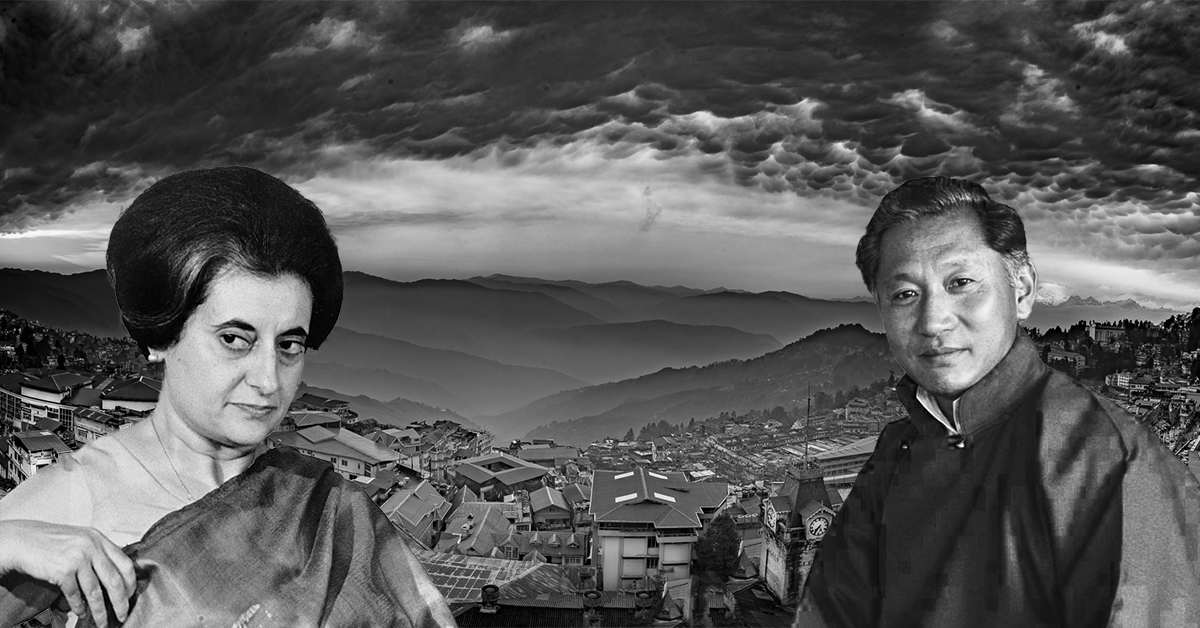This is part four of the series “The Last Chogyal of Sikkim”. Read part one here.
Jawaharlal Nehru, the Prime Minister of India, is dead. If Mohandas Gandhi was the Father of India, Nehru was the teacher who sculpted it and reintroduced it to the world. His better-known friend paved the way to Indian independence, but it was Nehru’s sixteen-year reign that brought the country there, ushering in and protecting a new era of self-governance and modernity.
Reeling from the death of their titanic leader, India fills his seat first with Lal Bahadur Shastri, a less colossal figure who’d previously served as Minister of Home Affairs and whose proudest accomplishment will be increasing India’s milk supply. He’ll call it the “white revolution”.
Shastri’s time in power is short-lived. On his watch, relations between India and Pakistan buckle and come to their inevitable head in a seventeen-day war over the mountain territories of Jammu and Kashmir. The Indian Prime Minister flies to Soviet Uzbekistan to sign a treaty ending the war, but he’s found dead there the next day. His wife and many of his supporters alleged that he’d been poisoned.
In all, Shastri lasted two years as Indian PM, sandwiched tightly between the longtime rule of one of the country’s founders, Jawaharlal Nehru, and the near-as-long reign of Nehru’s daughter, the insurgent leader Indira Gandhi. If Jawaharlal Nehru is one of the heroes of Chogyal Palden Thondup Namgyal’s story, Indira Gandhi may be its paramount villain.
Indira
Before her ascension to India’s highest office, Indira Gandhi served as assistant to her father, a member of the upper house of India’s parliament, and as Minister of Information and Broadcasting in the cabinet of her predecessor. Her appointment was something of a calculated move by the higher-ups in her party, the Indian National Congress, who saw her as a weak leader they could control. Early on, Indian independence advocate Ram Manohar Lohia called her a goongi gudiya, or “dumb doll”, referencing popular expectations for her rule. Characterized over and over as impotent, the new prime minister sets out to prove her critics wrong.
Early on, Indira follows in her father’s footsteps in engagements with Sikkim, entertaining the Chogyal’s attempts to maintain independence. She sees him relatively frequently at her seat in New Delhi and makes occasional visits to the Sikkimese capital city of Gangtok.
Initially, the Chogyal feels grateful to be able to work with the daughter of his ally and friend. But the peace cannot last forever. Despite the dedication and relative experience of each, the King and Queen of Sikkim remain amateurs at the art of statecraft. Gyalmo Hope, the American Queen, makes the second of her unintentionally-disastrous moves when she dips her toe in the field of academia and writes a history piece about the city of Darjeeling and how it was stolen by the British. It’s a true story, but she fails to realize what the “stolen city” argument might look like to India, Darjeeling’s current dad.
The incident sends small shockwaves through Sikkim and India, leaving the Gyalmo on the defensive. Infinitely larger are those cast by the Indian election of 1967, which transforms Indira Gandhi from fill-in leader to full-on Prime Minister. She has the same powers she’s had, but now she has a mandate to rule.
The tension pendulum swings back toward its more chaotic end as conflict flares in both Sikkim and its neighboring states. Within the Chogyal’s domain, the people are orienting themselves about a new political axis that extends from the King’s own goal of treaty reform on one end to dissolution of the monarchy and transition to democracy on the other. The Chogyal has, by now, spent years fighting for the former, but the latter is becoming increasingly popular among the people of Sikkim. The worsening state of the Nepali community doesn’t exactly help the monarchist cause.
The neighbors are fighting
Meanwhile, two separate conflicts bloom next door: first, a revolutionary communist faction, the Naxalites, comes to prominence in Eastern India with influence stretching into the Sikkim-bordering province of West Bengal. On the other side of West Bengal, a second conflict heats up in East Pakistan. Despite its name, East Pakistan and Pakistan (then West Pakistan) were distant friends, separated by well over a thousand miles. That physical and cultural distance didn’t make it into the equation when the two would-be Pakistans were united as one in the British-led (and botched) partition of India. While the West Pakistan-dominated Pakistani government sees itself as a unified country of South Asian Muslims, East Pakistanis increasingly see themselves as a people dominated by a government a thousand miles (and a billion people) away.
War breaks out in East Pakistan between those loyal to Greater Pakistan and those who want to form their own state, Bangladesh. India interferes on behalf of the rebels and supplements their troop numbers with Tibetan refugees. Some of the Tibetans will later remark about the irony of successfully fighting for the independence of a nation that is not their own.
Emboldened by that success in Bangladesh and her surging popularity in India, Indira Gandhi and her government begin to tighten the noose around Sikkim. With a strong communist movement surging in West Bengal and chances of a reversal of the Chinese annexation of Tibet plummeting, India grows increasingly worried that Sikkim will succumb to Chinese influence or fall to Chinese invasion.
Python molurus
By this point, India’s level of control over Sikkimese affairs is overpowering; the Indian army has 25,000 troops stationed in the country and all outside money, goods, and people have to go through India to get to Sikkim. At some point, Indian authorities begin opening Sikkimese mail. The Gyalmo Hope writes about the invasion of privacy in her memoirs, but it stretches beyond a political survey of the royal family; the headmistress of the local school warns her own family that her correspondence is being opened and uses coded messages (less CIA spy language and more “written in Scots”, which is honestly just as strong an encryption method. Good luck finding an Indian intelligence agent who can speak Scots.).
As India closes in on Sikkim, some loyalists begin to push back. The Sikkimese government publishes a criticism of their Indian counterparts. Unfortunately, this public levying of complaints goes against the treaty that governs the two countries’ relations and the Chogyal is forced to publicly apologize.
Unsurprisingly, internal concerns of growing Indian dominance don’t disappear overnight. Sikkim holds elections in 1972 and a party in favor of revising the bilateral treaty wins an overwhelming majority. India plays its hand, acquiescing to the idea of treaty revision but suggesting the new treaty place Sikkim in “indefinite association” with India, making it a sort of South Asian Puerto Rico. Sikkim refuses that offer immediately.
The Chogyal wins a personal victory when he convinces New Delhi to name him dewan, the effective Prime Minister of the country and another role India alone has authority to appoint.
The Chogyal’s additional layer of power placates him, at least for the moment, but the nation’s Nepali minority doesn’t see cause for celebration. Still understandably upset by a government structured to underrepresent them, they go to the two-hat-wearing Chogyal/Dewan and ask him to improve their situation. On the steps of the palace he shrugs and sends them away claiming that only the elected council can make a change — his hands are tied. It’s technically the truth, but it’s a convenient answer; the Chogyal isn’t interested in increasing Nepali representation. He’s got a different future for Sikkim on his mind.
It’s everyone’s dreams and fears for Sikkim that drive this era: the Nepalese want equitable representation in government; the Chogyal and his loyalists fear giving power to the Nepali majority would erode the country’s native Bhutia-Lepcha culture. The Chogyal wants total independence for his country; India fears an unfettered Sikkim would drift too close to China’s orbit. Sikkim appeals to the world for UN recognition; both the United States and China see the plea as a rehash of a historical episode where Joseph Stalin managed to snag UN seats for both Ukraine and Belarus despite their subservience to the greater Soviet Union — a seat for Sikkim is great so long as it doesn’t simply become a second seat for India.
For years, these conflicting motivations keep Sikkim deadlocked. But as Indira Gandhi’s government finally begins to stretch its legs, trickles of change fall in the eastern Himalayas. First, seeing the Chogyal increasingly as a roadblock to their ultimate ambitions in Sikkim, India begins to build relationships within the growing pro-democracy anti-Chogyal movement. Emboldened, the leader of that movement, the Kazi, locks two members of the Executive Council away in his house to prevent them from voting contrary to his (and India’s) interests. The game has begun.
Next to move is the Chogyal, who, despite his near-total power, feels unable to act against the Kazi who, by now, is at the height of his popularity. The Chogyal calculates carefully and decides to strike back, not directly at the Kazi, but instead broadly at his faction. He arrests the leader of the country’s other opposition party, a man who works closely with the Kazi (but not beneath him). In the Chogyal’s mind, he’s firing bullets, but only adjacent to his true target. Unfortunately, to the people of Sikkim, the king is shooting blind and it looks like he doesn’t really care who he hits. The move backfires (obviously, the Chogyal just arrested a rando for someone else’s crime), and a large protest starts to form outside the palace.
The Kazi himself arrives at the palace and hands the Chogyal a note demanding first the release of the arrested whipping boy councilor and second the adoption of a one-man-one-vote policy.
The Chogyal smiles a familiar smile as he dredges out one of his hits for the crowd, reminding them that, as amending the council is the council’s responsibility, his hands are tied. Once more, the crowd is placated on the basis of the King’s favorite technicality.
Most of the people forming the gathered mass return to their homes, but a few ethnic Nepalis stay and begin a short-lived hunger strike that comes with long consequences. Each of the men leave long before starvation starts to manifest, but their persistence gives continuum to the movement and leads straight into a second, larger movement.
This second gathering is one the Chogyal can’t just wave away with a brief paraphrasing of the constitution, partially because evidence suggests many of its members had been bussed across the Indian border. Instead, he goes further and agrees to do what has been within his power the whole time: releasing the unfairly-arrested opposition leader.
Later, a representative of the Chogyal’s attends a meeting of the Executive Council and reveals that the Chogyal has also acquiesced to the one-man-one-vote demand. With this and the reversal of his misguided imprisonment plan, the Kazi and his European allies have everything they asked for. The vote is expected to pass smoothly. But then, unexpectedly, the Kazi excuses himself from the meeting to take a phone call. When he returns, he announces that the deal, the one he fought strongest for, is off. It’s not clear who he talked to. Much more clear is what’s coming next.
Next time: The fall of Sikkim
Image
- Panoramic View of Darjeeling by Saurabh Chatterjee (Edited)





